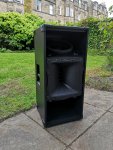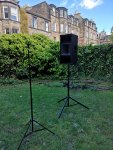Both speakers are excellent - FWIW I used the 8NW650 in my lined array - at the time it was slightly better than what B&C had on offer but B&C have some new drivers that can match it now.
The limiting factor for low frequency performance is usually Xmax and the speakers ability to remain linear and not have the cone's position bias in one direction when driven hard. Newer speakers tend to be much better in this respect as they have been designed with the help Kipple measurements.
My double 10 is crossed at 110Hz to the sub (double 18" 18NLW9601) and 650Hz to HF950/BMS4594 .... if you go any lower with sub crossover the 10" driver will be a noticeable limit on the systems max output.
This boxes has been one of the most useful speakers I have ever owned; the double 12 came about as a result of looking for something best describes as a super version of this box.
The limiting factor for low frequency performance is usually Xmax and the speakers ability to remain linear and not have the cone's position bias in one direction when driven hard. Newer speakers tend to be much better in this respect as they have been designed with the help Kipple measurements.
My double 10 is crossed at 110Hz to the sub (double 18" 18NLW9601) and 650Hz to HF950/BMS4594 .... if you go any lower with sub crossover the 10" driver will be a noticeable limit on the systems max output.
This boxes has been one of the most useful speakers I have ever owned; the double 12 came about as a result of looking for something best describes as a super version of this box.





